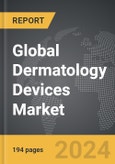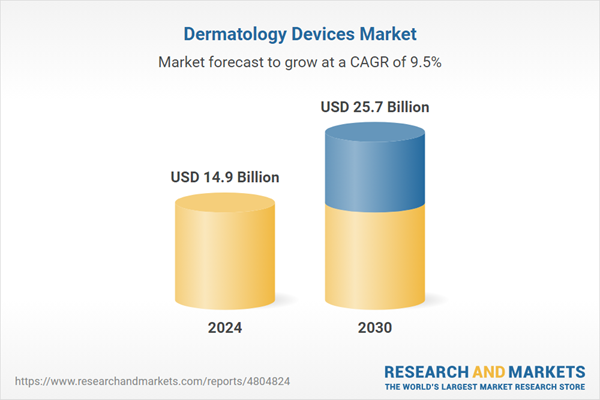The global market for Dermatology Devices was valued at US$14.9 Billion in 2024 and is projected to reach US$25.7 Billion by 2030, growing at a CAGR of 9.5% from 2024 to 2030. This comprehensive report provides an in-depth analysis of market trends, drivers, and forecasts, helping you make informed business decisions. The report includes the most recent global tariff developments and how they impact the Dermatology Devices market.
Segments: Type (Treatment Devices, Diagnostic Devices); End-Use (Hospitals, Clinics, Other End-Uses).
Geographic Regions/Countries: World; United States; Canada; Japan; China; Europe (France; Germany; Italy; United Kingdom; Spain; Russia; and Rest of Europe); Asia-Pacific (Australia; India; South Korea; and Rest of Asia-Pacific); Latin America (Argentina; Brazil; Mexico; and Rest of Latin America); Middle East (Iran; Israel; Saudi Arabia; United Arab Emirates; and Rest of Middle East); and Africa.
The analysts continuously track trade developments worldwide, drawing insights from leading global economists and over 200 industry and policy institutions, including think tanks, trade organizations, and national economic advisory bodies. This intelligence is integrated into forecasting models to provide timely, data-driven analysis of emerging risks and opportunities.
Global Dermatology Devices Market - Key Trends and Drivers Summarized
How Are Modern Dermatology Devices Redefining Skin Care Treatments?
Dermatology devices are instruments and apparatus used to diagnose, monitor, and treat skin conditions and diseases ranging from acne and eczema to melanoma. These devices include diagnostic tools like dermatoscopes and imaging systems, treatment devices such as laser machines, and other skin rejuvenation products. Advances in technology have significantly broadened the scope of dermatological treatments that can be offered, with state-of-the-art devices enabling more precise diagnoses and more effective, minimally invasive treatments. For instance, laser therapies now precisely target different skin layers to treat specific conditions without damaging surrounding tissues. Additionally, light-based therapies like intense pulsed light (IPL) are increasingly used for a variety of purposes, from hair removal to correcting pigment issues, offering alternatives to traditional procedures that often require longer recovery times and pose greater risks.What Technologies Are Driving Innovations in Dermatology Devices?
Innovation in dermatology devices is heavily influenced by developments in electronic and digital technologies. For example, teledermatology has become a fast-growing field within medical practice, powered by advances in mobile technologies and imaging. This method allows for remote diagnosis and treatment of patients, making dermatological care accessible to wider populations, including those in remote areas. Artificial intelligence (AI) is another cutting-edge technology being incorporated into dermatological devices. AI algorithms are used to enhance the accuracy of diagnoses from imaging devices and are particularly effective in identifying patterns in skin diseases early on. Moreover, the integration of AI helps streamline operational efficiencies in dermatological practices by automating routine tasks and analyzing patient data to predict treatment outcomes. This convergence of technology not only improves patient care but also optimizes the workflow within dermatological practices.How Are Changing Demographics and Lifestyle Factors Influencing the Demand for Dermatology Devices?
The global demographic shift towards an older population has a profound impact on the dermatology devices market. As the population ages, the demand for cosmetic and anti-aging treatments has increased, driving investments in devices that offer these services. Treatments such as laser resurfacing, microdermabrasion, and skin rejuvenation are particularly popular among this demographic. Furthermore, increased exposure to environmental factors such as pollution and ultraviolet radiation has heightened awareness about skin health, pushing the demand for skin monitoring and care devices. Lifestyle changes, including increased disposable income and greater spending on wellness and aesthetics, have also contributed to the expansion of the dermatology device sector. Additionally, social media and the public portrayal of 'ideal' beauty standards continue to influence individuals’ decisions to undergo cosmetic procedures, thus boosting the market for related dermatological equipment.What Drives the Growing Market for Dermatology Devices?
The growth in the dermatology devices market is driven by several factors, including technological advancements in device manufacturing, an increase in skin disorders, and a rising number of aesthetic and cosmetic procedures. Innovations such as laser therapies and non-invasive treatment solutions have not only broadened the range of applications for these devices but have also improved patient outcomes and satisfaction. Moreover, growing health insurance coverage for dermatological conditions has made treatments more accessible to a larger segment of the population. The influence of the beauty industry, coupled with an increasing emphasis on skin health, has further propelled the demand for advanced skin care solutions. Another significant driver is the educational and training opportunities available for dermatologists, which enhance their ability to adopt and utilize cutting-edge devices in their practices. These factors collectively contribute to the robust growth and dynamic changes within the global market for dermatology devices.Report Scope
The report analyzes the Dermatology Devices market, presented in terms of units. The analysis covers the key segments and geographic regions outlined below.Segments: Type (Treatment Devices, Diagnostic Devices); End-Use (Hospitals, Clinics, Other End-Uses).
Geographic Regions/Countries: World; United States; Canada; Japan; China; Europe (France; Germany; Italy; United Kingdom; Spain; Russia; and Rest of Europe); Asia-Pacific (Australia; India; South Korea; and Rest of Asia-Pacific); Latin America (Argentina; Brazil; Mexico; and Rest of Latin America); Middle East (Iran; Israel; Saudi Arabia; United Arab Emirates; and Rest of Middle East); and Africa.
Key Insights:
- Market Growth: Understand the significant growth trajectory of the Treatment Devices segment, which is expected to reach US$20.5 Billion by 2030 with a CAGR of a 10.0%. The Diagnostic Devices segment is also set to grow at 7.9% CAGR over the analysis period.
- Regional Analysis: Gain insights into the U.S. market, valued at $4.0 Billion in 2024, and China, forecasted to grow at an impressive 13.6% CAGR to reach $5.7 Billion by 2030. Discover growth trends in other key regions, including Japan, Canada, Germany, and the Asia-Pacific.
Why You Should Buy This Report:
- Detailed Market Analysis: Access a thorough analysis of the Global Dermatology Devices Market, covering all major geographic regions and market segments.
- Competitive Insights: Get an overview of the competitive landscape, including the market presence of major players across different geographies.
- Future Trends and Drivers: Understand the key trends and drivers shaping the future of the Global Dermatology Devices Market.
- Actionable Insights: Benefit from actionable insights that can help you identify new revenue opportunities and make strategic business decisions.
Key Questions Answered:
- How is the Global Dermatology Devices Market expected to evolve by 2030?
- What are the main drivers and restraints affecting the market?
- Which market segments will grow the most over the forecast period?
- How will market shares for different regions and segments change by 2030?
- Who are the leading players in the market, and what are their prospects?
Report Features:
- Comprehensive Market Data: Independent analysis of annual sales and market forecasts in US$ Million from 2024 to 2030.
- In-Depth Regional Analysis: Detailed insights into key markets, including the U.S., China, Japan, Canada, Europe, Asia-Pacific, Latin America, Middle East, and Africa.
- Company Profiles: Coverage of players such as 3Gen, Inc., Bruker Corporation, Carl Zeiss A/S, Cutera, Inc., Cynosure, Inc. and more.
- Complimentary Updates: Receive free report updates for one year to keep you informed of the latest market developments.
Some of the 42 companies featured in this Dermatology Devices market report include:
- 3Gen, Inc.
- Bruker Corporation
- Carl Zeiss A/S
- Cutera, Inc.
- Cynosure, Inc.
- Genesis Biosystems, Inc.
- HEINE Optotechnik GmbH & Co. KG
- Lumenis Ltd.
- Michelson Diagnostics, Ltd.
- Photomedex, Inc.
- Valeant Pharmaceuticals International, Inc.
Tariff Impact Analysis: Key Insights for 2025
Global tariff negotiations across 180+ countries are reshaping supply chains, costs, and competitiveness. This report reflects the latest developments as of April 2025 and incorporates forward-looking insights into the market outlook.The analysts continuously track trade developments worldwide, drawing insights from leading global economists and over 200 industry and policy institutions, including think tanks, trade organizations, and national economic advisory bodies. This intelligence is integrated into forecasting models to provide timely, data-driven analysis of emerging risks and opportunities.
What’s Included in This Edition:
- Tariff-adjusted market forecasts by region and segment
- Analysis of cost and supply chain implications by sourcing and trade exposure
- Strategic insights into geographic shifts
Buyers receive a free July 2025 update with:
- Finalized tariff impacts and new trade agreement effects
- Updated projections reflecting global sourcing and cost shifts
- Expanded country-specific coverage across the industry
Table of Contents
I. METHODOLOGYII. EXECUTIVE SUMMARY2. FOCUS ON SELECT PLAYERSIII. MARKET ANALYSISSOUTH KOREAREST OF ASIA-PACIFICARGENTINABRAZILMEXICOREST OF LATIN AMERICAIRANISRAELSAUDI ARABIAUNITED ARAB EMIRATESREST OF MIDDLE EASTIV. COMPETITION
1. MARKET OVERVIEW
3. MARKET TRENDS & DRIVERS
4. GLOBAL MARKET PERSPECTIVE
UNITED STATES
CANADA
JAPAN
CHINA
EUROPE
FRANCE
GERMANY
ITALY
UNITED KINGDOM
SPAIN
RUSSIA
REST OF EUROPE
ASIA-PACIFIC
AUSTRALIA
INDIA
LATIN AMERICA
MIDDLE EAST
AFRICA
Companies Mentioned (Partial List)
A selection of companies mentioned in this report includes, but is not limited to:
- 3Gen, Inc.
- Bruker Corporation
- Carl Zeiss A/S
- Cutera, Inc.
- Cynosure, Inc.
- Genesis Biosystems, Inc.
- HEINE Optotechnik GmbH & Co. KG
- Lumenis Ltd.
- Michelson Diagnostics, Ltd.
- Photomedex, Inc.
- Valeant Pharmaceuticals International, Inc.
Table Information
| Report Attribute | Details |
|---|---|
| No. of Pages | 194 |
| Published | April 2025 |
| Forecast Period | 2024 - 2030 |
| Estimated Market Value ( USD | $ 14.9 Billion |
| Forecasted Market Value ( USD | $ 25.7 Billion |
| Compound Annual Growth Rate | 9.5% |
| Regions Covered | Global |









